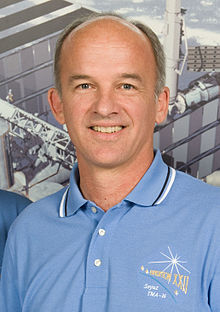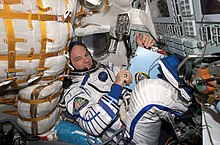Jeffrey Williams (astronaut)
Jeffrey Williams | |
|---|---|
 Williams in 2009 | |
| Born | Jeffrey Nels Williams (1958-01-18) January 18, 1958 (age 66) Superior, Wisconsin, U.S. |
| Education | United States Military Academy (BS) |
| Space career | |
| NASA astronaut | |
| Rank | Colonel, USA |
Time in space | 534d 2hm |
| Selection | NASA Group 16 (1996) |
Total EVAs | 5 |
Total EVA time | 31h 55m |
| Missions | STS-101 Soyuz TMA-8 (Expedition 13) Soyuz TMA-16 (Expedition 21/22) Soyuz TMA-20M (Expedition 47/48) |
Mission insignia |       |
Jeffrey Nels Williams (born January 18, 1958) is a retired United States Army officer and a NASA astronaut. He is a veteran of four space flights and formerly held the American record for most days spent in space, which was surpassed in April 2017 by his colleague Peggy Whitson.[1] He still holds the record of the longest time in space for an American man.
Early life and education
Williams was born in Superior, Wisconsin, and raised in Winter, Wisconsin. During his childhood, Williams reached the rank of Star Scout, the third-highest in the Boy Scouts of America.[2][3] During the Jamboree on the Air in October 2009 he communicated with Boy Scouts in the National Scouting Museum in Texas from the International Space Station.[3] Williams graduated from Winter High School in Winter, Wisconsin, in 1976. He earned a degree in applied science and engineering from the U.S. Military Academy in 1980, receiving his commission in the United States Army.
NASA career
Williams served with the Army at Johnson Space Center from 1987 to 1992 before training as a test pilot. In 1996, he was selected by NASA as an astronaut candidate. In July 2002, Williams served as the commander of the NEEMO 3 mission aboard the Aquarius underwater laboratory, living and working underwater for six days.[4][5]

STS-101
In 2000, Williams launched to space for the first time on STS-101. STS-101 delivered supplies to the International Space Station, hauled up using a Spacehab double module and an Integrated Cargo Carrier pallet. Williams and fellow crew member James Voss performed a spacewalk and then reboosted the station from 230 miles (370 km) to 250 miles (400 km). They returned to Earth after over 9 days on orbit.
Expedition 13

Williams also flew aboard the Soyuz TMA-8 mission, replacing Expedition 12 astronaut William S. McArthur. He was previously in orbit as the Expedition 13 flight engineer and science officer aboard the International Space Station. He returned to Earth on September 28, 2006.[6]
During his six-month stint at the International Space Station in 2006, Williams orbited the Earth more than 2,800 times. During Expedition 13, he worked on hundreds of experiments, walked in space twice, and captured more photographs of the Earth than any other astronaut in history. Many of his photos are found in his book The Work of His Hands: A View of God's Creation from Space, where he shares personal narrative and vivid photos of the Earth.
On August 24, 2006, a taped message made by him to be played at an official NASA press conference was accidentally played over the air-to-ground loop,[7] the tape revealing that the Crew Exploration Vehicle under development to replace the Space Shuttle after 2010 would be named Orion after the famed wintertime constellation.
Expedition 21/22
Williams also served as a flight engineer for Expedition 21 and assumed command of Expedition 22 in November 2009[8] having arrived on the International Space Station with his crew mates via Soyuz TMA-16 which launched on September 30, 2009.[9] Williams with Expedition 22 Flight Engineer Maksim Surayev landed their Soyuz TMA-16 spacecraft on the steppes of Kazakhstan on March 18, 2010, wrapping up a 167-day stay aboard the Space Station.
First live tweetup from space

On October 21, 2009, Williams and his Expedition 21 crewmate, Nicole Stott, participated in the first NASA Tweetup from the station with members of the public gathered at NASA Headquarters in Washington, D.C.[10] This involved the first live Twitter connection for the astronauts.[11] Previously, astronauts on board the Space Shuttle or ISS have sent the messages they desire to send as tweets down to Mission Control which then posted the message via the Internet to Twitter.[12]
Expedition 47/48

Williams returned to space station in 2016[13] as part of Expedition 47/48.[14] Upon the departure of Soyuz TMA-19M he became commander of Expedition 48.[15] Williams was returned to Earth safely on 6 September 2016.
On Expedition 47, Williams surpassed Scott Kelly's record of 520 cumulative days in space which was set when he returned from space on March 1, 2016; Williams beat this record with 534 cumulative days.[16]
Personal life
Williams is a committed Christian.[17] Following his return from the Expedition 21 mission, he wrote the book The Work of His Hands: A View Of God's Creation From Space about his experience in space. The book reflects in Williams words the "vivid lessons about the meticulous goodness of divine providence, God's care for His creation, and His wisdom in ordering the universe".[18] He is married to Anne-Marie Williams.[19]
Awards and decorations
  | Defense Superior Service Medal with oak leaf cluster |
  | Legion of Merit with oak leaf cluster |
  | Meritorious Service Medal with oak leaf cluster |
 | Army Commendation Medal |
  | National Defense Service Medal with award star |
 | Army Service Ribbon |
 | NASA Distinguished Service Medal |
 | NASA Exceptional Service Medal |
   | NASA Space Flight Medal with two oak leaf clusters |
See also
References
![]() This article incorporates public domain material from websites or documents of the National Aeronautics and Space Administration.
This article incorporates public domain material from websites or documents of the National Aeronautics and Space Administration.
- ^ Amanda Barnett and Eleanor Mueller (April 24, 2017). "Trump congratulates NASA astronaut". CNN. Retrieved August 24, 2020.
- ^ "Astronauts and the BSA". Fact sheet. Boy Scouts of America. Archived from the original on April 14, 2009. Retrieved March 20, 2006.
- ^ a b "Jamboree-on-the-Air and Jamboree-on-the-Internet Extravaganza". Boy Scouts of America. Archived from the original on June 20, 2010. Retrieved June 8, 2010.
- ^ NASA (April 21, 2011). "Life Sciences Data Archive : Experiment". NASA. Archived from the original on October 24, 2011. Retrieved September 22, 2011.
- ^ Montoya, Donald (Summer 2002). "Army Space Command Astronaut Trains for Life in Space -- Underwater". The Army Space Journal. 1 (3). Army Space Command. Archived from the original on March 31, 2012. Retrieved December 21, 2011.
- ^ "Space Station Crew Back on Earth". NASA. September 28, 2006. Retrieved March 19, 2016.
- ^ "NASA lets name of new vehicle slip early". Sarasota Herald Tribune. August 22, 2006. Retrieved January 29, 2023.
- ^ Trinidad, Katherine (November 21, 2008). "NASA Assigns Space Station Crews, Updates Expedition Numbering". NASA. Retrieved January 29, 2023.
- ^ "Expedition 21 Soyuz Launch". NASA TV. September 30, 2009. Archived from the original on December 31, 2009.
- ^ Carla Cioffi (October 21, 2009). "20091021 NASA Live Tweetup Event with International Space Station". NASA.
- ^ John Yembrick (October 1, 2009). "NASA Hosts Long-Distance Tweetup with Astronauts on Space Station". NASA. Retrieved October 20, 2009.
- ^ Etan Horowitz (May 22, 2009). "The great debate over Astro Mike's 'tweets from space'". The Orlando Sentinel. Archived from the original on May 25, 2009. Retrieved October 2, 2009.
- ^ Joshua Buck (February 11, 2014). "NASA, International Space Station Partners Announce Future Crew Members". NASA.
- ^ "Launch, Docking Returns International Space Station Crew to Full Strength". NASA. March 19, 2016. Retrieved March 19, 2016.
- ^ Mark Garcia (June 17, 2016). "NASA Astronauts Swap Station Command". blogs.nasa.gov. Archived from the original on May 5, 2022. Retrieved June 19, 2016.
- ^ "Jeffrey N. Williams, (Colonel, U.S. Army, Ret.) NASA Astronaut" (PDF). NASA. May 2019. Archived from the original (PDF) on October 15, 2022. Retrieved December 3, 2023.
- ^ Williams, Jeffrey (June 1, 2010). The Work of His Hands: A View Of God's Creation From Space. Concordia Publishing House. p. 149. ISBN 978-0758615893.
- ^ Williams, Jeffrey (June 1, 2010). The Work of His Hands: A View Of God's Creation From Space. Concordia Publishing House. p. back cover. ISBN 978-0758615893.
- ^ "Soyuz Expedition 22 lifts off with Wisconsin astronaut". September 30, 2009.
External links

- Jeffrey Williams' book The Work of His Hands: A View of God's Creation from Space
- Jeffrey Williams on Twitter

- "Jeffrey N. Williams, (Colonel, U.S. Army, Ret.) NASA Astronaut" (PDF). NASA. May 2019. Retrieved June 24, 2021.
- Spacefacts biography of Jeffrey N. Williams
- Jeff Williams Enters the BEAM Module
| Preceded by | ISS Expedition Commander November 30, 2009 to March 17, 2010 | Succeeded by |
| Preceded by | ISS Expedition Commander June 18, 2016 to September 6, 2016 | Succeeded by |


















